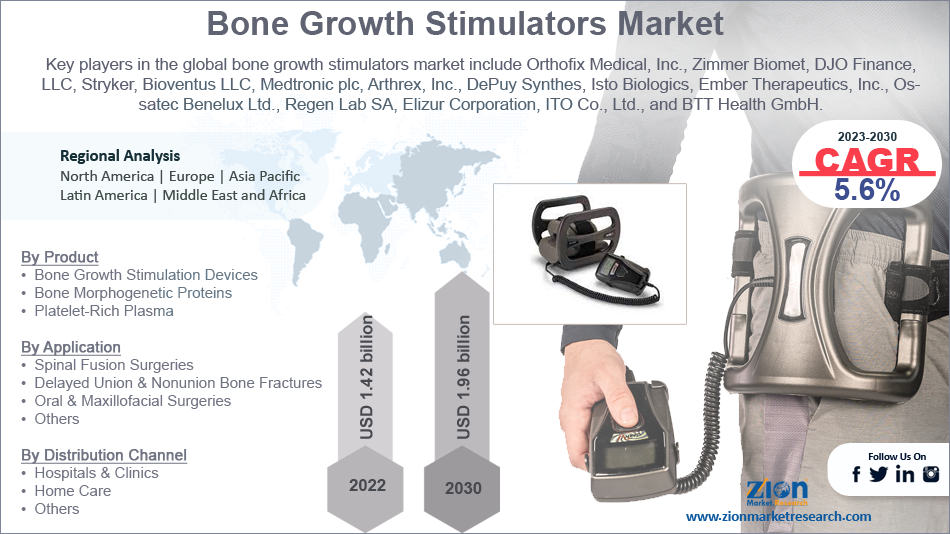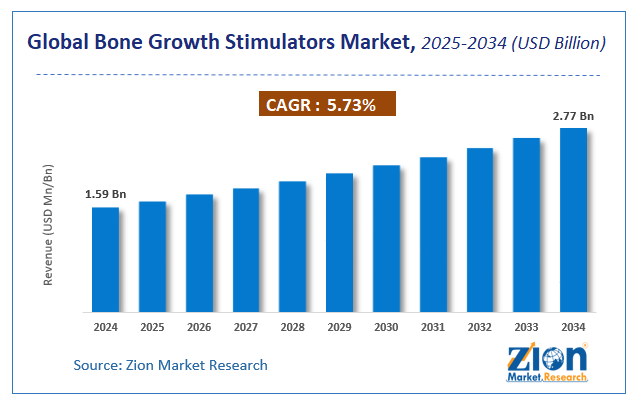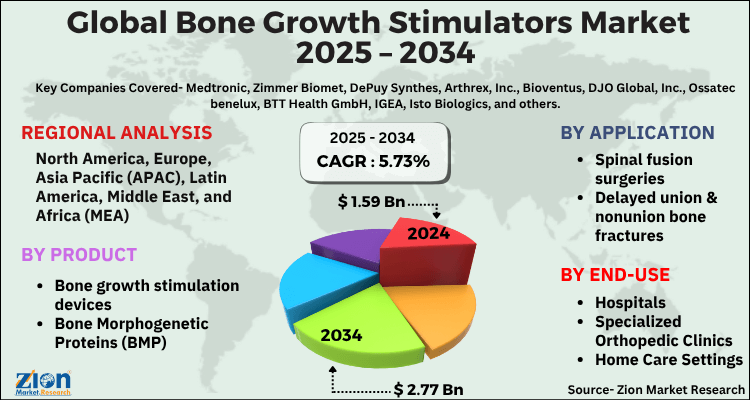Global Bone Growth Stimulators Market Size, Share, Growth Analysis Report - Forecast 2034

Bone Growth Stimulators Market By Product (Bone growth stimulation devices, Bone Morphogenetic Proteins (BMP), Platelet-Rich Plasma (PRP)), By Application (Spinal fusion surgeries, Delayed union & nonunion bone fractures, Orthopedic trauma surgeries, Others), By End-use (Hospitals, Specialized Orthopedic Clinics, Home Care Settings, Ambulatory Surgical Centers), and By Region: Global and Regional Industry Overview, Market Intelligence, Comprehensive Analysis, Historical Data, and Forecasts 2025 - 2034
| Market Size in 2024 | Market Forecast in 2034 | CAGR (in %) | Base Year |
|---|---|---|---|
| USD 1.59 Billion | USD 2.77 Billion | 5.73% | 2024 |
Global Bone Growth Stimulators Market: Industry Perspective
The global bone growth stimulators market size was worth around USD 1.59 Billion in 2024 and is predicted to grow to around USD 2.77 Billion by 2034 with a compound annual growth rate (CAGR) of roughly 5.73% between 2025 and 2034. The report analyzes the global bone growth stimulators market's drivers, restraints/challenges, and the effect they have on the demands during the projection period. In addition, the report explores emerging opportunities in the bone growth stimulators industry.
The report analyzes the bone growth stimulators market’s drivers, restraints/challenges, and the effect they have on the demands during the projection period. In addition, the report explores emerging opportunities in the bone growth stimulators market.
Global Bone Growth Stimulators Market: Overview
Bone growth stimulation promotes bone healing in difficult-to-heal fractures or fusions by administering an ultrasonic or electrical current to the fracture site. This is done by an electrical osteogenesis stimulator, it’s a device that stimulates bone regeneration via electrical stimulation. Electrical stimulation can be administered from the outside (noninvasive) or the interior of the body (invasive). An external power supply is connected to electrodes or coil implanted on the skin or plaster or brace over a fusion or fracture site in a noninvasive electrical stimulator. A noninvasive device that generates low intensity, pulsed ultrasound is known as an ultrasonic osteogenesis stimulator. In order to encourage fracture healing, an ultrasonic signal is given to the skin surface at the fracture region through ultrasound conductive coupling gel.
 Request Free Sample
Request Free Sample
Global Bone Growth Stimulators Market: Growth Drivers
Increase patient preference towards minimally invasive and non-invasive surgical operations.
Because of the benefits offered by non-invasive and minimally invasive treatments over standard treatment techniques, there has been a huge growth in demand for them. Less operating problems, nominal hospitalization, smaller aesthetic incisions, less discomfort, minimal risk of infection, shortened postoperative care, and quicker recovery are all advantages of minimally invasive treatments. In minimally invasive treatments, advanced technology is used to detect and treat several disorders, including cancer. These treatments are intended to remove malignant tumors and lymph nodes from the body without leaving scars. These factors are contributing to the market growth.
Bone Growth Stimulators Market: Restraints
Limitations for medical reimbursement for bone stimulating procedures may hinder the market growth.
At a country level, medical reimbursement is one of the most important variables influencing the acceptance and demand of certain diagnostic or therapeutic goods among patients and healthcare professionals. In developed nations (such as the United States and Australia), the majority of healthcare insurance companies cover bone growth stimulation drugs provided certain requirements are met.
In the United States, for example, insurance provided for bone growth stimulation devices providing the target bones are apart by less than one centimeter and are not diseased. According to the Part B schedule, Medicare also covers bone growth stimulating devices and provides device rental on a prescription basis but for various purposes. Moreover, many private insurance companies, on the other hand, do not cover or reimburse bone growth stimulating operations, thereby hindering market growth to some extent.
Bone Growth Stimulators Market: Opportunities
Increasing demand for bone growth stimulators in emerging countries will provide better growth opportunities to the market.
Emerging economies like India, China, Mexico, and Brazil are likely to offer considerable growth potential for the bone growth stimulators market. Factors such as a large population of patients, soaring healthcare spending, increasing government support for the healthcare industry, bolstering export trade, and increasing awareness among surgeons, physicians, and patients regarding the latest treatment options for spinal fusion and bone therapies are estimated to bolster the requirement for bone growth stimulation devices. Furthermore, many patients from established countries are known to fly to these emerging nations for medical care because of the huge cost savings.
Bone Growth Stimulators Market: Challenges.
Side-effects of BMP-based orthopedic therapy pose a major challenge to expanding the market growth.
Even though BMPs are increasingly being employed in bone healing and spinal fusion, they are linked to several negative side effects. The most common adverse effects of BMPs following spinal fusion surgery include tissue edema, implant dislodgement, and male infertility. BMPs have been linked to antigenic responses and oncogene activation during bone repair. During the use of Medtronic's BMP product in spinal fusion procedures for bone repair, the company identified various clinical problems.
Key Insights
- As per the analysis shared by our research analyst, the global bone growth stimulators market is estimated to grow annually at a CAGR of around 5.73% over the forecast period (2025-2034).
- Regarding revenue, the global bone growth stimulators market size was valued at around USD 1.59 Billion in 2024 and is projected to reach USD 2.77 Billion by 2034.
- The bone growth stimulators market is projected to grow at a significant rate due to increasing incidence of bone disorders and injuries, a rising geriatric population prone to fractures, growing preference for minimally invasive and non-invasive surgical treatments, and continuous technological advancements in bone growth stimulation dev.
- Based on Product, the Bone growth stimulation devices segment is expected to lead the global market.
- On the basis of Application, the Spinal fusion surgeries segment is growing at a high rate and will continue to dominate the global market.
- Based on the End-use, the Hospitals segment is projected to swipe the largest market share.
- Based on region, North America is predicted to dominate the global market during the forecast period.
Global Bone Growth Stimulators Market: Report Scope
| Report Attributes | Report Details |
|---|---|
| Report Name | Bone Growth Stimulators Market |
| Market Size in 2024 | USD 1.59 Billion |
| Market Forecast in 2034 | USD 2.77 Billion |
| Growth Rate | CAGR of 5.73% |
| Number of Pages | 200 |
| Key Companies Covered | Medtronic, Zimmer Biomet, DePuy Synthes, Arthrex, Inc., Bioventus, DJO Global, Inc., Ossatec benelux, BTT Health GmbH, IGEA, Isto Biologics, and others. |
| Segments Covered | By Product, By Application, By End-use, and By Region |
| Regions Covered | North America, Europe, Asia Pacific (APAC), Latin America, The Middle East and Africa (MEA) |
| Base Year | 2024 |
| Historical Year | 2020 to 2023 |
| Forecast Year | 2025 - 2034 |
| Customization Scope | Avail customized purchase options to meet your exact research needs. Request For Customization |
Global Bone Growth Stimulators Market: Segmentation
The global bone growth stimulators market is categorized into product, application, end-use and region. All the segments have been analyzed based on present and future trends and the market is estimated from 2025 to 2034.
Based on product, the market is segmented based on bone growth stimulation devices, bone morphogenetic proteins, and platelet-rich plasma. The bone growth stimulation devices segment held the largest market share in 2022 and is further expected to grow rapidly at a significant CAGR during the forecast period.
The major reason for the growth of this segment is an increase in the cases of spinal deformities among people, growth in the geriatric population in various countries across the globe, and persistent improvements and technological advancements in bone growth stimulation devices. However, on the other hand, the platelet-rich plasma segment is expected to cite a notable growth rate during the forecast period. The growth of this segment is due to an increase in demand for plasma therapy in numerous orthopedic therapeutic applications.
Based on application, the market is segmented based on spinal fusion surgeries, delayed union & non-union bone fractures, oral & maxillofacial surgeries, and others. The spinal fusion segment held the largest market share in 2022 and is expected to occupy a dominant status and simultaneously grow at a remarkable CAGR during the forecast period.
The major reason for the growth of this segment is the increase in the adoption of minimally invasive spinal surgeries, the rise in the cases of degenerative spinal conditions among people, growing incidences of obesity, and the surge in the popularity of spinal fusion surgery procedures in various countries around the world.
By End-use, the global bone growth stimulators market is split into Hospitals, Specialized Orthopedic Clinics, Home Care Settings, Ambulatory Surgical Centers.
The Regional, this segment includes the current and forecast demand for North America, Europe, Asia Pacific, Latin America,and the Middle East and Africa.
Recent Developments
- In April 2024, Orthofix signed an exclusive licensing deal with IGEA to sell the company's breakthrough soft tissue, cartilage, and bone stimulation solutions in the United States and Canada.
- In November 2024, Wright Medical was purchased by Stryker for USD 5.4 billion. Stryker's position in the orthopedics device industry was reinforced as a result of the purchase.
- In June 2024, DePuy Synthes and the AO Foundation extended their cooperation to promote patient care and outcomes via innovation and AO's independent worldwide education programs.
Global Bone Growth Stimulators Market: Regional Landscape
The bone growth stimulators market demonstrates varying growth trends across regions, driven by differences in healthcare infrastructure, patient awareness, and technological adoption. North America holds a dominant share due to advanced healthcare systems, rising incidences of bone-related disorders, and growing acceptance of non-invasive therapies. Europe follows closely, supported by increasing orthopedic surgeries and favorable reimbursement policies. Meanwhile, the Asia-Pacific region is witnessing the fastest growth, fueled by expanding healthcare access, a rising geriatric population, and heightened awareness of innovative treatment options. Latin America and the Middle East & Africa are emerging markets, showing steady progress as investments in healthcare infrastructure rise and the demand for advanced medical devices increases. Overall, global market dynamics reflect a strong push towards minimally invasive treatments and accelerated healing solutions, sustaining demand for bone growth stimulators worldwide.
Global Bone Growth Stimulators Market: Competitive Analysis
The report provides a company market share analysis to give a broader overview of the key market players. In addition, the report also covers key strategic developments of the market, including acquisitions & mergers, new product launches, agreements, partnerships, collaborations & joint ventures, research & development, and regional expansion of major participants involved in the bone growth stimulators market on a global and regional basis.
The global bone growth stimulators market is dominated by players like:
- Medtronic
- Zimmer Biomet
- DePuy Synthes
- Arthrex Inc.
- Bioventus
- DJO Global Inc.
- Ossatec benelux
- BTT Health GmbH
- IGEA
- Isto Biologics
Global Bone Growth Stimulators Market: Segmentation Analysis
The global bone growth stimulators market is segmented as follows;
By Product
- Bone growth stimulation devices
- Bone Morphogenetic Proteins (BMP)
- Platelet-Rich Plasma (PRP)
By Application
- Spinal fusion surgeries
- Delayed union & nonunion bone fractures
- Orthopedic trauma surgeries
- Others
By End-use
- Hospitals
- Specialized Orthopedic Clinics
- Home Care Settings
- Ambulatory Surgical Centers
Global Bone Growth Stimulators Market: Regional Segment Analysis
- North America
- The U.S.
- Canada
- Mexico
- Europe
- France
- The UK
- Spain
- Germany
- Italy
- Rest of Europe
- Asia Pacific
- China
- Japan
- India
- Australia
- South Korea
- Rest of Asia Pacific
- The Middle East & Africa
- Saudi Arabia
- UAE
- Egypt
- Kuwait
- South Africa
- Rest of the Middle East & Africa
- Latin America
- Brazil
- Argentina
- Rest of Latin America
Table Of Content
Methodology
FrequentlyAsked Questions
Bone growth stimulation promotes bone healing in difficult-to-heal fractures or fusions by administering an ultrasonic or electrical current to the fracture site. This is done by an electrical osteogenesis stimulator, it’s a device that stimulates bone regeneration via electrical stimulation. Electrical stimulation can be administered from the outside (noninvasive) or the interior of the body (invasive). An external power supply is connected to electrodes or coil implanted on the skin or plaster or brace over a fusion or fracture site in a noninvasive electrical stimulator.
The global bone growth stimulators market is expected to grow due to rising prevalence of bone-related disorders, increasing geriatric population, advancements in non-invasive therapies, and growing demand for faster recovery post-surgery.
According to a study, the global bone growth stimulators market size was worth around USD 1.59 Billion in 2024 and is expected to reach USD 2.77 Billion by 2034.
The global bone growth stimulators market is expected to grow at a CAGR of 5.73% during the forecast period.
North America is expected to dominate the bone growth stimulators market over the forecast period.
Leading players in the global bone growth stimulators market include Medtronic, Zimmer Biomet, DePuy Synthes, Arthrex, Inc., Bioventus, DJO Global, Inc., Ossatec benelux, BTT Health GmbH, IGEA, Isto Biologics, among others.
The report explores crucial aspects of the bone growth stimulators market, including a detailed discussion of existing growth factors and restraints, while also examining future growth opportunities and challenges that impact the market.
RelatedNews
HappyClients
Zion Market Research
Tel: +1 (302) 444-0166
USA/Canada Toll Free No.+1 (855) 465-4651
3rd Floor,
Mrunal Paradise, Opp Maharaja Hotel,
Pimple Gurav, Pune 411061,
Maharashtra, India
Phone No +91 7768 006 007, +91 7768 006 008
US OFFICE NO +1 (302) 444-0166
US/CAN TOLL FREE +1 (855) 465-4651
Email: sales@zionmarketresearch.com
We have secured system to process your transaction.
Our support available to help you 24 hours a day, five days a week.
Monday - Friday: 9AM - 6PM
Saturday - Sunday: Closed






